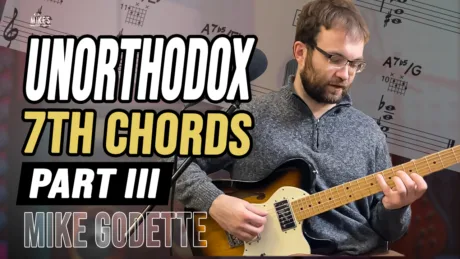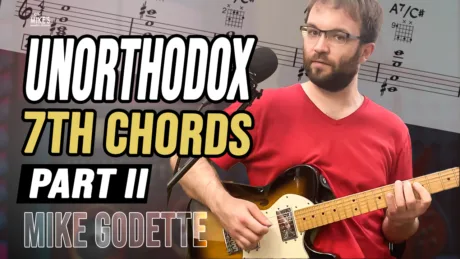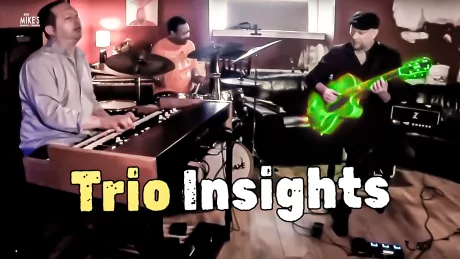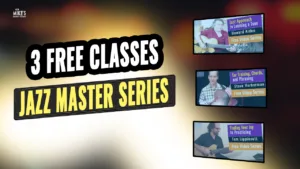Composition + Improvisation = ‘Comprovisation’!
Over the years as a teacher, the question I’ve probably been asked more than any other is: “What can I do to get more vocabulary into my solos?”. Meanwhile, another very common enquiry is: “What’s the most efficient way to go about transcribing?”, which implies a similar sort of overall aim.
Even students who know their theory (and are already engaging in transcription tasks) sometimes express frustrations like “it still doesn’t sound like jazz when I do it” or perhaps “it takes so long for any of it to actually come out in my own playing”. There’s no magic wand, of course, but nevertheless I do think there are ways to speed all this up, so that we can quickly assimilate the sounds we hear, and avoid wasting time. After all, it’s perfectly possible to spend weeks transcribing a long solo, only to look back a year later and realize that virtually nothing has stuck.
The advice I generally give is that, if we want “vocabulary” to appear in our improvised solos, we have to spend time consciously creating it in the practise room. However many scales we know, and however many solos we’ve transcribed, the things we’re hoping to hear aren’t just going to fall out of our instruments. Instead, we may need to think a little bit more like composers, and consider the musical architecture of the ideas we’re going to play; whether these are of our own making, or taken from a recorded source. How is the new phrase structured? How could we develop the idea, and where might it fit in with our existing ones? If it’s someone else’s, how can we make it feel like it’s ours?
None of this is to say that we want our solos to consist entirely of pre-meditated licks or that we shouldn’t aspire to hear spontaneous melodies in the moment of delivery. It’s just that our musical engine needs more specific fuel than a bunch of scales and arpeggios (even the really clever ones) can provide.
In the full 1h15m class:
• We look at nine different melodic ideas from diverse sources such as Oscar Peterson, Joe Henderson, Dizzy Gillespie, and John Coltrane. The ideas reference both mainstream and contemporary styles; some are also taken from famous composed melodies.
• We analyze the structure of each one and consider how it might be expanded beyond its original context.
• Using well-known tunes as “test beds” for the resulting vocabulary, I demonstrate how I might end up employing the ideas, in contexts that may be quite different from the original source.
• A selection of the resulting lines are then transcribed (and tabbed out) in the accompanying PDF booklet.
• Synchronized on-screen captions and timecodes mean that you can always cross-reference between the video and the written materials.












Jamie, “KNOCKED IT OUT THE PARK” with this Masterclass
“Comprovisation” The missing Link, what a great introduction to playing patterns or melodic fragments as Jamie presents them. I am glad Jamie opens up the video explaining that Comprovisation is a word he made up. In short, it is condition (pattern) playing combined with spontaneous expression (improvisation). Jamie is quick to point out that these are not licks, but compositional elements borrowed from other sources. If you have the time, I suggest that you listen to the original source material to fully comprehend the potential of the pattern/fragment. Jamie borrows material for his patterns from the jazz repository: Strong melodic fragment from a well-known standard, melodic fragment(s) from a Jazz icon’s solo that he extended into a pattern(s), Scale fragments and arpeggios.
To get the most out of the material, you should probably have a rudimental knowledge of chord progressions and harmony. The value of practicing patterns is understanding the musical situation the pattern fits in. In my opinion, practicing patterns in the wrong place or wrong key can be counter-productive. Jamie helps with this effort by listing the chords for most of the progressions and walks you through his thought process for applying the patterns to common progressions. Specifically, how to work your way into the pattern and how to work your way out of the pattern and resolving to the tonic of the key.
This is an excellent way to absorb the jazz language. By continuously practicing this material and constantly adding to the patterns contained in this masterclass; hopefully, you will find that this material will integrate with sounds that you are already familiar with, and become a part of your muscle memory. And ultimately, be improvised and performed effortlessly in the moment. Good luck, and thank you Jamie for another great class.
by Gy MotenHe did it again!
Not every musician is a good teacher, but Jamie definitely is both. If you are (like myself) well informed, have practised hours, days and years, but your playing is still somehow just about average than I strongly recommend Jamies videos (all of them). He seems to know my questions, shows me exactly what to do or redo or makes me look at well known material from a new and more acessible point of view.
I just love it.
by Mano Flick